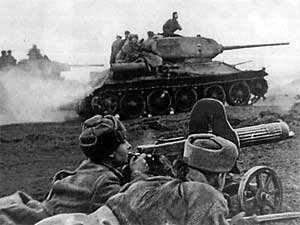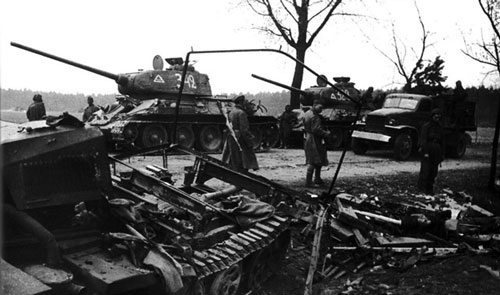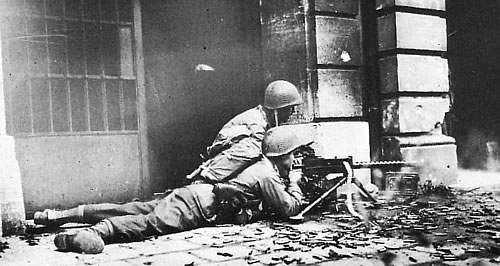Not really "Back to Bagration", but the alliteration could not be resisted ! Have not played this historical era before, but working on it ! Maybe the title of this post should read "Backed by Bagration" reflecting the triple whammy landed on Hitler's Third Reich:
In Italy the fall of Monte Cassino, then Rome; in Normandy the D-Day landings, followed by Bagration in the East 1944 would deliver a series of crippling blows from which Reich could not recover.
Working away at my Fall/Autumn Russian 1/72 army for a few weeks:
Have almost finished my Siberian ski troops, all based now, just needing one more coat of paint.
Multiple Zis 3 76 mm Guns and 4 x 122 mm Howitzers at the ready, PTRDs and Maxim guns by the handfuls. Darn fiddly those Esci/Matchbox Maxims!

From Wiki: Operation Bagration (Russian: Oперация Багратион, Operatsiya Bagration) was the codename for the Soviet 1944 Belorussian Strategic Offensive Operation during World War II, which cleared German forces from the Belorussian SSR and eastern Poland between 22 June and 19 August 1944.
The operation was named after 18th–19th century Georgian Prince Pyotr Bagration, general of the Imperial Russian Army who received a mortal wound at the Battle of Borodino.

The operation resulted in the almost complete destruction of an entire German army group, with the loss of Army Group Centre's Fourth Army, Third Panzer Army and Ninth Army. It is considered the most calamitous defeat experienced by the German armed forces during the Second World War.
By the end of the operation most of the western Soviet Union had been liberated and the Red Army had achieved footholds in Romania and Poland. German losses eventually numbered well over half a million men killed or wounded, even higher than the toll at Verdun in 1916.
The Soviet armies directly involved in Operation Bagration were the 1st Baltic Front under Army General Ivan Bagramyan, the 1st Belorussian Front commanded by Army General Konstantin Rokossovsky, the 2nd Belorussian Front commanded by Colonel-General G. F. Zakharov, and the 3rd Belorussian Front commanded by Colonel-General Ivan Chernyakhovsky.

The objectives of the operation were complicated. The Red Army practiced the concept of Soviet deep battle and maskirovka. One American author suggests that these Soviet innovations were enabled, in part, by the provision of over 220,000 trucks by the United States to motorize the Soviet infantry. It has been suggested that the primary target of the Soviet offensive was the bridgehead on the Vistula river in central Poland, and that Operation Bagration was to create a crisis in Belorussia to divert German mobile reserves to the central sectors as a part of maskirovka, removing them from the Lublin-Brest, Lvov–Sandomierz area where the Soviets intended to undertake the Lvov–Sandomierz Offensive and Lublin–Brest Offensive.
This allowed the Red Army to reach the Vistula river and Warsaw, which in turn put Soviet forces within striking distance of Berlin, conforming to the concept of Soviet deep operations — striking deep into the German force's strategic depths.
Background
Army Group Centre had previously proved tough to counter as the Soviet defeat in Operation Mars had shown. But by June 1944, despite shortening its front line, it had been exposed following the withdrawals of Army Group South in the battles that followed the Battle of Kursk, the Second Battle of Kiev and the Crimean Offensive in the late summer, autumn and winter of 1943–44, which the Soviets called the Third period of World War II. Operation Suvorov had seen Army Group Centre itself forced to retreat westwards from Smolensk during the autumn of 1943.

By the middle of June 1944, the Western Allies on the Cotentin Peninsula were just over 1,000 km (620 mi) from Berlin, while the Soviet forces at the Vitebsk Gate were within 1,200 km (750 mi) of the German capital. For the Third Reich, the strategic threats were about the same. Hitler underestimated the threat posed by Soviet troops facing Army Group Centre, and had redeployed ⅓ of Army Group Centre's artillery, ½ their tank destroyers and 88% of their tanks to the Southern front where the German high command expected the next major Soviet offensive to come. Army Group center only had a total of 580 tanks, tank-destroyers and assault guns. They were opposed by over 9000 Soviet machines. The redeployment of forces from Army Group Center left only 80 men defending every kilometer of the front line.

Bagration, in combination with the neighbouring Lvov-Sandomierz Offensive launched a few weeks later in Ukraine, allowed the Soviet Union to recapture Belorussia and Ukraine within its 1941 borders, advance into German East Prussia, but more importantly, the Lvov-Sandomierz operation allowed the Red Army to reach the outskirts of Warsaw after gaining control of Poland east of the Vistula river. The operation enabled the next operation, Vistula–Oder Offensive, to come within sight of the German capital. The Soviets were initially surprised at their success of the Belorussian operation which had nearly reached Warsaw. The Soviet advance encouraged the Warsaw uprising against the German occupation forces.
The battle has been described as the triumph of the Soviet theory of "the operational art" because of the complete co-ordination of all the Strategic Front movements and signals traffic to fool the enemy about the target of the offensive. The military tactical operations of the Red Army successfully avoided the mobile reserves of the Wehrmacht and continually "wrong-footed" the German forces. Despite the huge forces involved, Soviet front commanders left their adversaries completely confused about the main axis of attack until it was too late.

5th Guards advance during Operation Bagration
The end of Operation Bagration coincided with the destruction of many of the strongest units of the German Army on the western front in the Falaise pocket in Normandy. The number of troops involved and especially personnel and material losses inflicted on the Wehrmacht was much bigger in Bagration than in Normandy.
After these stunning victories, on both eastern and western fronts, supply problems rather than German resistance slowed the subsequent rapid Allied advance, and it eventually ground to a temporary halt.
However, the Germans were able to transfer armoured units from the Italian front, where they could afford to give ground, to resist the Soviet advance near Warsaw.





